| Reading Formation Stratigraphic range: Paleocene | |
|---|---|
| Type | Formation |
| Unit of | Lambeth Group |
| Underlies | Harwich Formation |
| Overlies | Upnor Formation (London Basin), Chalk Group (Hampshire Basin) |
| Thickness | Up to 27 m, generally 12 to 16 m |
| Lithology | |
| Primary | Clay |
| Other | Sand |
| Location | |
| Region | England |
| Country | United Kingdom |
| Extent | London Basin, Hampshire Basin |
| Type section | |
| Named for | Reading, Berkshire |
The Reading Formation is a geologic formation in southern England. It dates to the Paleocene period, and is part of the Lambeth Group. It overlies the London Basin and is below the Harwich Formation. [1] The formation is composed of "a series of lenticular mottled clays and sands, here and there with pebbly beds and masses of fine sand converted into quartzite. These beds are generally unfossiliferous." [2]
During the late medieval era, the Surrey whitewares pottery kilns were located near the Reading Formation, most notably the area between Farnham and Tongham The beds were an excellent source of white-firing clay. [3]
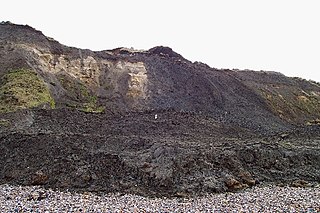
The London Clay Formation is a marine geological formation of Ypresian age which crops out in the southeast of England. The London Clay is well known for its fossil content. The fossils from the lower Eocene rocks indicate a moderately warm climate, the tropical or subtropical flora. Though sea levels changed during the deposition of the clay, the habitat was generally a lush forest – perhaps like in Indonesia or East Africa today – bordering a warm, shallow ocean.

The geology of Hertfordshire describes the rocks of the English county of Hertfordshire which are a northern part of the great shallow syncline known as the London Basin. The beds dip in a south-easterly direction towards the syncline's lowest point roughly under the River Thames. The most important formations are the Cretaceous chalks, which are exposed as the high ground in the north and west of the county, and the Cenozoic rocks made up of the Paleocene age Reading beds and Eocene age London Clay that occupies the remaining southern part.

Greensand or green sand is a sand or sandstone which has a greenish color. This term is specifically applied to shallow marine sediment that contains noticeable quantities of rounded greenish grains. These grains are called glauconies and consist of a mixture of mixed-layer clay minerals, such as smectite and glauconite mica. Greensand is also loosely applied to any glauconitic sediment.
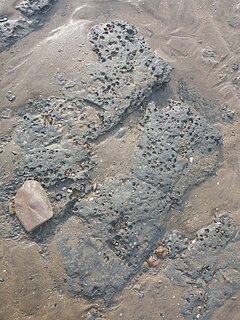
Weald Clay or the Weald Clay Formation is a Lower Cretaceous sedimentary rock underlying areas of South East England, between the North and South Downs, in an area called the Weald Basin It is the uppermost unit of the Wealden Group of rocks within the Weald Basin, and the upper portion of the unit is equivalent in age to the exposed portion of the Wessex Formation on the Isle of Wight. It predominantly consists of thinly bedded mudstone. The un-weathered form is blue/grey, and the yellow/orange is the weathered form, it is used in brickmaking.

The Lambeth Group is a stratigraphic group, a set of geological rock strata in the London and Hampshire Basins of southern England. It comprises a complex of vertically and laterally varying gravels, sands, silts and clays deposited between 56-55 million years before present during the Ypresian age. It is found throughout the London Basin with a thickness between 10m and 30m and the Hampshire Basin with a thickness between 50m and less than 25m. Although this sequence only crops out on the edges of these basins, the fact that the Lambeth Group underlies some 25% of London at a depth of less than 30m means the formation is of engineering interest for tunnelling and foundations.
In geology, the Bagshot Beds are a series of sands and clays of shallow-water origin, some being fresh-water, some marine. They belong to the upper Eocene formation of the London and Hampshire basins, in England and derive their name from Bagshot Heath in Surrey. They are also well developed in Hampshire, Berkshire and the Isle of Wight. The following divisions are generally accepted:
The Bovey Formation is a deposit of sands, clays and lignite, probably over 1000 feet thick. It lies in a sedimentary basin termed the Bovey Basin which extends from Bovey Tracey to Newton Abbot in South Devon, England. The Bovey Basin lies along the line of the Sticklepath fault and owes its existence to subsidence along this fault.
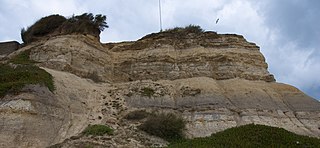
The Wealden Group, occasionally also referred to as the Wealden Supergroup, is a group in the lithostratigraphy of southern England. The Wealden group consists of paralic to continental (freshwater) facies sedimentary rocks of Berriasian to Aptian age and thus forms part of the English Lower Cretaceous. It is composed of alternating sands and clays. The sandy units were deposited in a flood plain of braided rivers, the clays mostly in a lagoonal coastal plain.

The London Basin is an elongated, roughly triangular sedimentary basin approximately 250 kilometres (160 mi) long which underlies London and a large area of south east England, south eastern East Anglia and the adjacent North Sea. The basin formed as a result of compressional tectonics related to the Alpine orogeny during the Palaeogene period and was mainly active between 40 and 60 million years ago.

The Hampshire Basin is a geological basin of Palaeogene age in southern England, underlying parts of Hampshire, the Isle of Wight, Dorset, and Sussex. Like the London Basin to the northeast, it is filled with sands and clays of Paleocene and younger ages and it is surrounded by a broken rim of chalk hills of Cretaceous age.
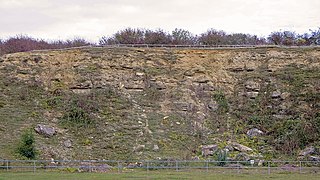
The Forest Marble is a geological formation in England. Part of the Great Oolite Group, it dates to back to the late Bathonian stage of the Middle Jurassic.

The Lower Greensand Group is a geological unit, which forms part of the underlying geological structure of southeast England. South of London in the counties of West Sussex, East Sussex, Surrey and Kent, which together form the wider Weald, the Lower Greensand can usually be subdivided to formational levels with varying properties into the Atherfield Clay Formation, the Hythe Formation, the Sandgate Formation, and the Folkestone Formation. In areas north and west of London, including Cambridgeshire, Bedfordshire and Buckinghamshire the Lower Greensand is referred to as the Woburn Sands Formation. In Oxfordshire it is known as the Faringdon Sand. In North Wiltshire as the Calne Sands Formation and in parts of Wiltshire, Oxfordshire and Buckinghamshire as the Seend Ironstone Formation.

The geology of East Sussex is defined by the Weald–Artois anticline, a 60 kilometres (37 mi) wide and 100 kilometres (62 mi) long fold within which caused the arching up of the chalk into a broad dome within the middle Miocene, which has subsequently been eroded to reveal a lower Cretaceous to Upper Jurassic stratigraphy. East Sussex is best known geologically for the identification of the first dinosaur by Gideon Mantell, near Cuckfield, to the famous hoax of the Piltdown man near Uckfield.

The Tunbridge Wells Sand Formation is a geological unit which forms part of the Wealden Group and the uppermost and youngest part of the unofficial Hastings Beds. These geological units make up the core of the geology of the Weald in the English counties of West Sussex, East Sussex and Kent.

The Ashdown Formation is a geological unit, which forms part of the Wealden Group and the lowermost and oldest part of the now unofficial Hastings Beds. These geological units make up the core of the Weald in the English counties of East Sussex and Kent.

The Wadhurst Clay Formation is a geological unit which forms part of the Wealden Group and the middle part of the now unofficial Hastings Beds. These geological units make up the core of the geology of the High Weald in the English counties of West Sussex, East Sussex and Kent.
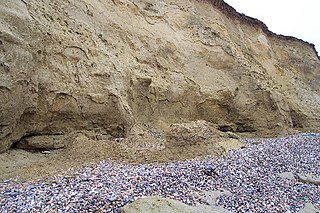
The Thanet Formation is a geological formation found in the London Basin of southeastern England. It is of early to mid-Thanetian age and gave its name to that stratigraphic interval. It was previously known as the Thanet Beds, the Thanet Sands and the Thanet Sand Formation. It was named after the Isle of Thanet. The type sections are Herne Bay in Kent for the upper part of the formation and Pegwell Bay for the lower part. It lies unconformably on the Late Cretaceous Chalk Group. It unconformably underlies the Lambeth Group, generally the Upnor Formation but in Essex it is the Reading Formation.
The geology of West Sussex in southeast England comprises a succession of sedimentary rocks of Cretaceous age overlain in the south by sediments of Palaeogene age. The sequence of strata from both periods consists of a variety of sandstones, mudstones, siltstones and limestones. These sediments were deposited within the Hampshire and Weald basins. Erosion subsequent to large scale but gentle folding associated with the Alpine Orogeny has resulted in the present outcrop pattern across the county, dominated by the north facing chalk scarp of the South Downs. The bedrock is overlain by a suite of Quaternary deposits of varied origin. Parts of both the bedrock and these superficial deposits have been worked for a variety of minerals for use in construction, industry and agriculture.

Surrey whiteware or Surrey white ware, is a type of lead-glazed pottery produced in Britain from the 13th to the 16th centuries. The white-fired sandy earthenware was produced largely from kilns in Surrey and along the Surrey-Hampshire border. Surrey whitewares were the most commonly used pottery in London during the late medieval period. There are four classes of Surrey whiteware: Kingston-type, Coarse Border ware, Cheam whiteware and Tudor Green ware.

Border ware is a type of post-medieval British pottery commonly used in London during the sixteenth and seventeenth centuries. The lead-glazed, sandy earthenware was produced from kilns along the border between Hampshire and Surrey. There are two classes of Border ware, fine whitewares and fine redwares.
| This article about a specific stratigraphic formation in the United Kingdom is a stub. You can help Wikipedia by expanding it. |
| This article related to the Paleogene period is a stub. You can help Wikipedia by expanding it. |
| This England-related article is a stub. You can help Wikipedia by expanding it. |